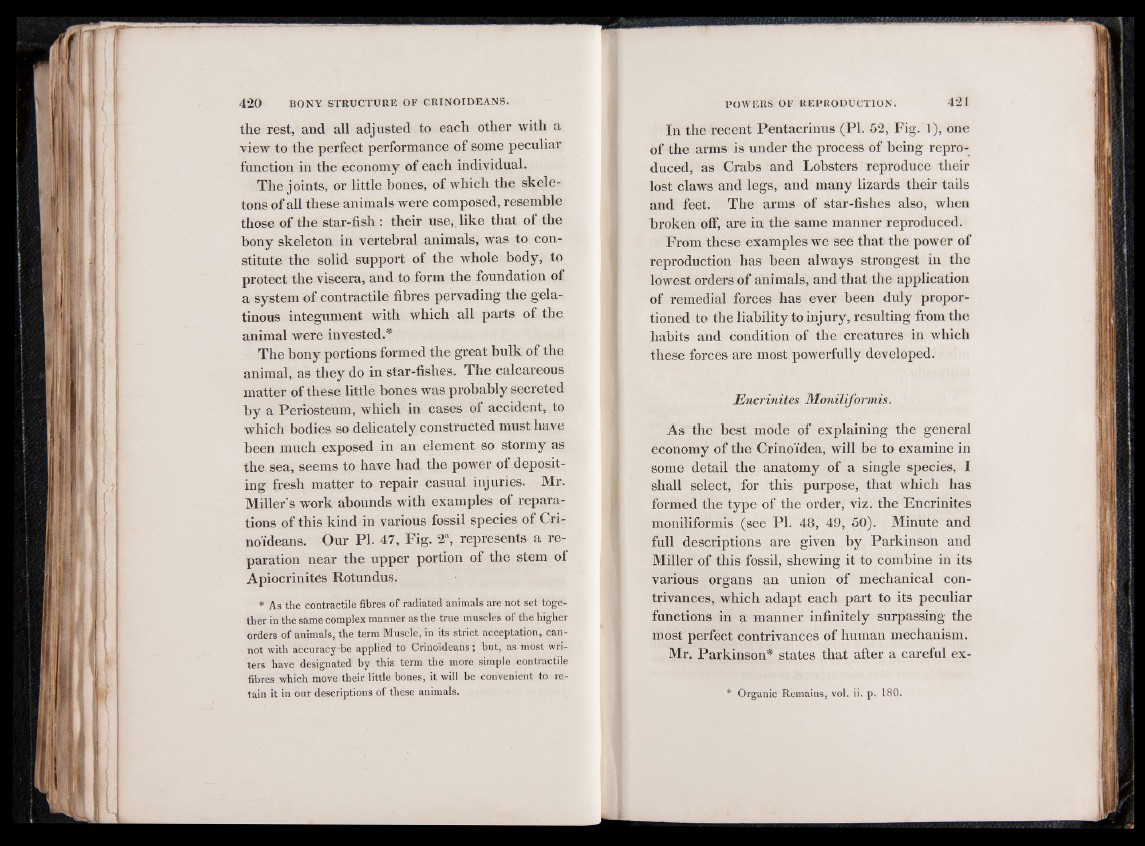
the rest, and all adjusted to each other with a
view to the perfect performance of some peculiar
function in the economy of each individual.
The joints, or little hones, of which the skeletons
of all these animals were composed, resemble
those of the star-fish : their use, like that of the
bony skeleton in vertebral animals, was to constitute
the solid support of the whole body, to
protect the viscera, and to form the foundation of
a system of contractile fibres pervading the gelatinous
integument with which all parts of the
animal were invested.*
The bony portions formed the great bulk of the
animal, as they do in star-fishes. The calcareous
matter of these little bones was probably secreted
by a Periosteum, which in cases of accident, to
which bodies so delicately constructed must have
been much exposed in an element so stormy as
the sea, seems to have had the power of depositing
fresh matter to repair casual injuries. Mr.
Miller’s work abounds with examples of reparations
of this kind in various fossil species of Cri-
noideans. Our PI. 47, Fig. 2a, represents a reparation
near the upper portion of the stem of
Apiocrinites Rotundus.
* As the contractile fibres of radiated animals are not set together
in the same complex manner as the true muscles of the higher
orders of animals, the term Muscle, in its strict acceptation, cannot
with accuracy be applied to Crinoideans; but, as most writers
have designated by this term the more simple contractile
fibres which move their little bones, it will be convenient to retain
it in our descriptions of these animals.
In the recent Pentacrinus (PI. 52, Fig. 1), one
of the arms is under the process of being reproduced,
as Crabs and Lobsters reproduce their
lost claws and legs, and many lizards their tails
and feet. The arms of star-fishes also, when
broken off, are in the same manner reproduced.
From these examples we see that the power of
reproduction has been always strongest in the
lowest orders of animals, and that the application
of remedial forces has ever been duly proportioned
to the liability to injury, resulting from the
habits and condition of the creatures in which
these forces are most powerfully developed.
Encrinites Moniliformis.
As the best mode of explaining the general
economy of the Crino’idea, will be to examine in
some detail the anatomy of a single species, I
shall select, for this purpose, that which has
formed the type of the order, viz. the Encrinites
moniliformis (see PI. 48, 49, 50). Minute and
full descriptions are given by Parkinson and
Miller of this fossil, shewing it to combine in its
various organs an union of mechanical contrivances,
which adapt each part to its peculiar
functions in a manner infinitely surpassing the
most perfect contrivances of human mechanism.
Mr. Parkinson* states that after a careful ex-
* Organic Remains, vol. ii. p. 180.